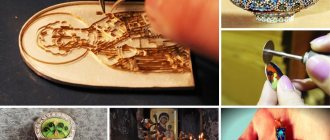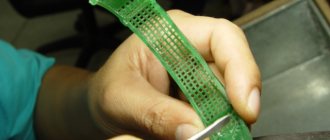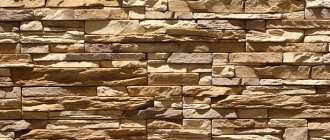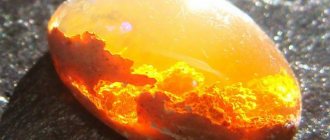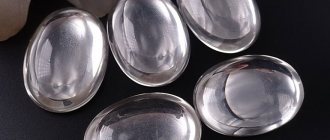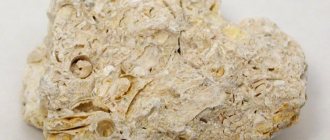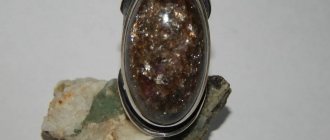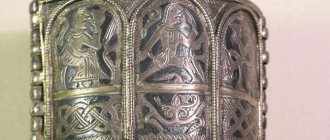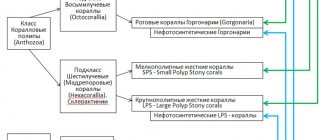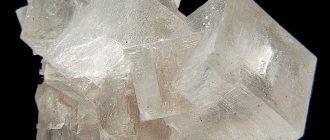Jewelry wax for modeling is widely used by jewelers; it is used to make prototypes of rings, earrings and other jewelry. Wax for jewelry has its own characteristics; it is produced using special wax processing products. Jewelry casting wax can be used for modeling and in other areas of production - you can cast anything from it. Spatulas and a jewelry wax injector are special tools for working with this material. Today we will talk about how to choose and where to buy jewelry wax.
Composition of jewelry model wax
Jewelry wax is a chemical composite of purified wax with impurities that is more similar in appearance to plastic than beeswax. It is very durable, but melts at a temperature of 70-100 degrees. These are important properties, since thin parts need to withstand various loads (removal from the mold, pouring in the flask).
Paraffin, ceresin, polyethylene, rosin, polystyrene, urea, and boric acid are used as additives that give the wax the necessary properties. Dyes are also added to mark different compositions. The pigment that is included in its composition does not affect the quality of the wax and the product can be of any color.
DEVELOPMENT OF RECIPLES FOR DOMESTIC FOUNDING WAXES
The selection of strengthening components and model compositions for precision investment casting was carried out according to the principle of conditionally dividing the components into 3 groups: fillers, strengtheners, plasticizers.
It was found that the filler component that best meets the requirements is highly purified microcrystalline petroleum paraffin, grade “A” [1].
The model composition must have sufficient hardness and strength during all technological operations.
Substances that increase the mechanical properties of model compositions are hardeners. They can be either natural or synthetic.
Natural substances that strengthen model compositions
Natural hardeners include substances of plant, animal and mineral origin.
Romonta
(mountain wax, GDR) - a mineral from the group of petroleum bitumens, genetically associated with deposits of paraffinic oil; is a mixture of high molecular weight solid saturated hydrocarbons; t° drop point = 84°C, linear shrinkage = 1.9%, hardness according to TIR = 95 arb. units, density = 1.005 g/cm3, ash content = 0.55%; colored dark brown or black, it is a hard material with brittle fracture.
Ceresin-80
is a mixture of solid isoparaffin hydrocarbons of the methane series. Ceresin is obtained in various ways: by processing and purifying ozokerite; from oil ceresin deposits formed on the walls of pipes of drilling wells, oil pipelines and oil storage facilities; from petrolatum. Ceresin-80 has the following physical and mechanical characteristics: drop t°. = 80°C, linear shrinkage = 3.8%, hardness according to TIR = 77 arb. units, density = 0.94 g/cm3, ash content = 0.03%.
The color of ceresin depends on the degree of purification and varies from yellow to white.
Lignite wax
- this is the organic part of the substance that goes into solution when brown coal is treated with organic solvents (dichloroethane, gasoline, alcohol-gasoline). Lignite wax consists of wax, resin parts and asphaltene-like impurities. The group composition of lignite wax significantly depends on the solvent used in the processing of brown coal. When used as a gasoline solvent, lignite wax has the following group composition:
waxes - 82.5%
paraffins - 8.6%
oils - 6.8%
asphaltenes - 2.1%
Physical and mechanical characteristics: t° cantilever. = 82-90°C, linear shrinkage = 2%, hardness according to TIR = 95 arb. units, density = 1.0–1.03 g/cm3, ash content = 0.6%.
In appearance, it is a solid dark brown product with a conchoidal fracture.
Montan (rolled) wax
obtained by extraction with organic solvents from brown coals. This wax consists mainly of esters of higher alcohols; it also contains free montanic acid C27H35COOH and its esters.
Physical and mechanical characteristics: drop t°. = 83°C, linear shrinkage = 3.87%, hardness according to TIR = 95 arb. units, density = 1.0 g/cm3; Ash content = 0.5-0.6%.
The color of montan wax depends on the extraction conditions and varies from brown to reddish-brown [2, 3].
Peat wax
- a dark brown solid obtained by processing peat. Main physical and mechanical characteristics: drop t°. = 75°C, linear shrinkage = 0.78%, hardness according to TIR = 91 arb. units, density = 1.008 g/cm3, ash content = 0.16%.
Carnauba wax
- Extracted from the leaves of wax palms native to Brazil and Venezuela. The chemical composition of carnauba wax is close to beeswax. Physical and mechanical characteristics: drop t°. = 81–86°С, hardness according to TIR = 96–98 arb. units, density = 0.990 - 0.996 g/cm3. Gray carnauba wax is a hard, brittle, gray-green substance. Gives a conchoidal fracture. Refined carnauba wax is produced by treating the raw wax with kaolin and various chemicals. It is a hard, brittle, yellow-green substance. Carnauba wax is soluble in boiling ethyl alcohol and ether.
Shellac wax
- a by-product in the production of alcoholic and aqueous-alcoholic solutions of shellac (finishing agents). Shellac wax is precipitated from these solutions as sludge, filtered and dried. Depending on the technology for isolating shellac wax, the physical and mechanical characteristics of the latter can vary within the following limits: drop t°. = 74 - 80°C, linear shrinkage = 2.2 - 2.4%, hardness according to TIR = 88 - 96 arb. units, density = 0.971 - 0.980 g/cm3, ash content == 0.12%. In appearance, shellac wax is a brown solid product.
As a result of studying the properties of hardening components of natural origin, it was found that mineral waxes and wax-like products are characterized mainly by high ash content (mountain, lignite, montan waxes), significant linear shrinkage (montan wax, ceresin-80) and adhesion to the mold; the use of carnauba wax, which has valuable properties, as a hardener for the model composition is limited, since carnauba wax is an imported product. For the preparation of bi- and polycomponent systems of variable composition, shellac wax is of greatest interest among the natural waxes under consideration.
Along with the analysis of strengthening components of natural origin, it seems advisable to consider synthetic wax-like products that have more stable properties compared to natural ones, ensuring the stability of the properties of systems [1].
Synthetic waxes
Synthetic waxes, or according to the classification of L. Ivanovsky “waxes of partial synthesis” [9], are waxes that are products of organic synthesis. The group of such waxes used abroad as hardeners for model compositions for precision investment casting can include products obtained by various syntheses. These syntheses are carried out on the basis of the condensation of compounds such as glycols and mono- and dibasic higher fatty acids, polyethylene glycols and higher fatty acids, cyclic imides and higher fatty acids, etc.
Imidovoski
Acrawax
- a complex of nitrogen-containing derivatives of higher fatty acids. It is produced by the condensation of cyclic imides and fatty acids such as stearic acid and its homologues.
These synthetic imid waxes are produced under the brands “A”, “B” and “C” with melting points of 95-97°, 86-90°, 140-143°C, respectively (according to N. Bennett, melting point 95-97°, 81 —84°, 137–139°С) [2, 3].
Аcrawax "A"
- hard wax of brown color (t° pl. = 95-97 ° C, density (24 ° C) = 1.04 g/cm3. It is combined with carnauba and other vegetable waxes, rosin, shellac, higher fatty acids, fats. Incompatible with paraffin and other mineral waxes.
Аcrawax "B"
— hard wax of brown color, t° pl. = 81 - 84°C, density (25°C) = 0.955 g/cm3. It has a good shiny surface and is similar in properties to Acrawax “A”.
Unlike Acrawax "A" it is compatible with paraffin and mineral waxes and can be added in an amount of 15%.
Acrawax "C"
— hard wax, light brown, t° pl. = 137 - 139°C, density (25°C) = 0.975 g/cm3; it is combined with paraffin and carnauba waxes, rosin, etc.
Synthetic imide waxes also include condensation products of phthalimide, succinimide and ε-caprolactam with stearic acid.
The products obtained as a result of condensation are solid wax-like substances, the melting point of which lies in the range of 45 - 59 ° C, the color is from yellowish to brown.
Amidovski
Armowax
— synthetic waxes, consisting mainly of N,N'-methylene bisstearamide [4]. According to other literature data, Armowax is a condensation product of amides of stearic and palmitic acids with formaldehyde [3]. The chemical and physical properties of Armowax obtained from these reactions are identical.
Armowax
- products are reddish-brown in color with a faint odor and a melting point of 132-135°C. Amid waxes are compatible with ceresin, ozokerite, carnauba and beeswax in all respects; they are mixed with paraffin in a 1:1 ratio; however, at a ratio of 1:10 they are partially mixed.
Stearanilide
- condensation product of aniline and stearic acid, solid, waxy; melting point 80 - 82°C, reddish-brown color.
Stearanilide has good binding characteristics. It is compatible with many waxes and wax-like products, including paraffin, carnauba, beeswax and synthetic waxes such as polyethylene waxes [2, 3, 4].
Wax-based polyesters
"Carbowax"
- the trade name of high-molecular (molecular weight > 500) polyethylene glycols, which are solid wax-like products that are obtained using the Carbide and Carbon Chemical Company (USA) process by polymerizing ethylene oxide under high pressure [3, 4].
Polyethylene glycols (“Carbowax”) can react with both unsaturated (for example, oleic acid) and saturated (for example, stearic acid) fatty acids to form liquid and solid substances. Industrial polyethylene glycol ethers are waxy solids. These include: "Carbowax 4000 (mono) laurate" (t° pl. = 50 - 60 ° C), "Polyethylene glycol 600 (mono) (di)-stearate" (t ° pl. = 24 - 26 ° C) and "Carbowax 4000 (mono) stearate" t° pl. = 54 - 57°C).
The composition of polyethylene polyol ethers includes polyhydric alcohols from low to high molecular weight with a molecular weight of 6000.
One mole of a fatty acid with one mole of a polyhydric alcohol produces a monoester, which is usually hydrophilic. Diesters are produced by the reaction of two moles of a fatty acid with one mole of a polyhydric alcohol. The practical use of polyglycol esters of fatty acids depends on their surface activity and emulsifying ability.
Carbowax 1000 (mono) stearate is a yellow, waxy solid, soluble in hot water [4, 5].
Wax-like polyesters are known, obtained by condensation of glycols with adipic, sebacic and stearic acids [6, 7, 8].
The product obtained by condensation of ethylene glycol with adipic acid is a white, waxy, solid mass with a melting point of 56 - 58 ° C, highly soluble in alcohol, chloroform and ethyl acetate.
Polyester, obtained by polycondensation of ethylene glycol with sebacic acid, is a wax-like solid mass with a melting point of 72 - 80 ° C (depending on the synthesis conditions) and linear shrinkage of 1.2 - 1.4%.
Diethylene glycol monostearate is obtained by condensation of diethylene glycol with stearic acid. Diethylene glycol monostearate is a yellowish, waxy, solid substance with a melting point of 51 - 54 ° C and a density of 0.96 g/cm3 [2].
Polyethylene waxes
- low molecular weight (molecular weight up to 2000) products obtained by thermal destruction of high molecular weight polyethylene at temperatures above 290°C in the absence of oxygen.
These products are a white or white with a grayish tint solid mass with a dropping point of 86 - 108 ° C, depending on the properties of the original polyethylene and the pyrolysis conditions. When choosing a hardening component, the most interesting are polyethylene waxes with a dropping point of 102.5 - 106 ° C, linear shrinkage = 3.5 - 4.6%, hardness according to TIR = 82 - 95 arb. units [1]. The named polyethylene waxes are well compatible with traditional wax-like materials: paraffin, ceresin, beeswax and others.
Synthetic ceresin-100
- a waxy, solid product, yellow in color, obtained by the synthesis of carbon monoxide and hydrogen, with a dropping point of 100°C, hardness according to TIR 93 arb. units, linear shrinkage 3.4% and density 0.936 g/cm3. Synthetic ceresin is characterized by a fine-crystalline structure and the absence of layering inherent in paraffin. It combines well with paraffin, stearin, shellac wax, rosin and other wax-like materials.
The considered synthetic wax-like products are widely used in foreign practice as hardening components for foundry waxes, mastics, pastes, etc.
We have carried out a number of syntheses in order to obtain synthetic products such as “Acrawax”, “Armowax”, “Carbowax”, etc., the introduction of which into model compositions significantly increases the mechanical properties of model systems.
At the same time, it should be noted that the industrial development of these products requires significant capital investments, and their high cost does not currently allow these products to be widely used as strengthening components for model compositions for precision casting. Suffice it to say that the cost of one ton of stearanilide, a synthetic wax-like product produced by the domestic industry, is now 44 thousand rubles.
In accordance with the above, of the synthetic hardeners considered, preference should be given to polyethylene socks and synthetic ceresin of the “100” brand, and ceresin-100 has the best properties, which, at the same hardness, has lower values of linear shrinkage and dropping temperature.
Thus, to compose double “filler-strengthener” systems, shellac wax was selected as strengthening components from natural group waxes, and ceresin-100 from synthetic ones. The physical and mechanical characteristics of the paraffin–shellac wax and paraffin–ceresin-100 systems are presented in Tables 1 and 2.
Analysis of the properties of the systems, paraffin—shellac wax and paraffin—ceresin-100, made it possible to establish the optimal ratios of components in the systems under consideration.
Based on the results obtained, in accordance with the requirements for the properties of the optimal model composition, the following conclusions were made:
1. It is advisable to introduce shellac wax into the model system in an amount of up to 50% by weight.
2. The content of synthetic ceresin grade 100 in the model system should not exceed 30% by weight.
How to choose jewelry wax
Jeweler's wax is a chemical composite of purified wax with impurities that is more similar in appearance to plastic than beeswax.
Jeweler's wax is used to make a variety of items. These can be watch cases, church souvenirs and other products. When choosing wax, pay attention to the following:
- It should have minimal shrinkage.
- The surface of the product must be glossy and clean.
- The melting point should be between 60-100 °C.
- The material must have sufficient fluidity.
Types of wax
There are two types of wax for jewelry: foundry and modeling. Modeling wax is more durable and is as hard as wood. It can be drilled, planed and sanded on a machine, even the smallest parts will be durable. Foundry wax is softer and more flexible; you don’t need a machine to work with it; you can cut out a shape with a minimal set of tools. Small parts made from such wax are more fragile; foundry wax is most often used for waxing. It is recommended that beginners start working with casting wax, as it is more plastic, pliable and melts faster.
Making stencils from jewelry wax
The work of making lost wax models begins with receiving an order - a task written on a special form. The master checks the numbers of the molds, that is, the rubber bands, with the numbers indicated in the work order.
Then the master cleans the mold from dust and wax residues. Depending on the complexity of the model and the features of the mold, some rubber bands are sprayed with silicone - the wax is easily separated from the rubber and does not break. Then all the components of the elastic are folded, only after that it is considered ready for use. Working with a manual injector. First, the waxer tightens the valve and manually pumps up the pressure, the height of which depends on the type of product.
Then the master firmly clamps the mold between two plastic dies, brings it to the injector nozzle and presses on it. Hot wax is poured into the gum and takes the shape of the model carved in it - the wax is ready!
By the way, in order for the wax to harden faster, the molds must be cold. Therefore, as the gums heat up, the waxer puts them in the freezer to cool. The finished samples, together with the work order, are submitted to the quality control inspector for inspection. Using a microscope, the specialist evaluates the quality of the work performed, and in the meantime the waxer can begin to perform the next job.
After quality control, prototypes of future products are soldered onto a wax rod. The result is a blank for casting in metal, resembling a Christmas tree. Making wax wood is a very painstaking job, since fragile models that fit tightly together are easy to damage. After this, the finished Christmas trees are sent to the casting area, where they are cast in metal.
Blue wax
The third type of wax is colored blue. This wax is so flexible that a 3 mm thick plate, held briefly in boiling water, can be bent into a semicircle. Of all the types of wax, Ferris Blue is the closest match to carving wood: white pine without knots or veins. This is the ideal wax for knife carving. Instead of powdery filings like green and flakes like purple, blue wax falls in fine shavings. No matter what size piece you need to cut or carve, if the knife is sharp enough, you won't have to worry about the material suddenly cracking. It is best to use a variety of special knives and cutters, such as a complex wood carving knife. And then, with due care, the result of your work will be quite comparable and, more likely, significantly superior to the best carved examples of boxwood.
Blue wax is used mainly due to its plasticity and unique melting behavior. Unlike the other two waxes, blue, which melts at 116°C, does not flow but maintains an amorphous structure, gradually changing viscosity with increasing temperature, allowing the modeler to precisely control how the new material bonds to the old.
It is produced in blocks, but cut into plates, it is much more flexible than purple, and is best suited for very thin products with a lot of openwork details, on which harder material can crack. Blue wax, even with a thickness of 1 mm, will withstand the pressure of your file, however, it will be deformed. It is not recommended for use where precise fitting of parts is expected - only for products that do not require a large number of relief parts and for products that are best made by combining carving and wax building techniques.
Blue wax can be filed well if you use medium-grit tools, no finer than #2, and work slowly. If you start to scrape impatiently and hastily, even with a coarse file, it will quickly clog, and the wax particles are so dense and flexible that they will get stuck between the teeth, and the tool can only be cleaned with a steel brush or a file cleaning brush. Therefore, it is better not to use a drill, well, except with the coarsest burs and at the lowest speed.
Spatulas and injector for working with jewelry wax
To make models from jewelry wax, or stencils, you need special equipment - injectors. There are two types of injectors: automatic vacuum and manual. Inside each of them, high pressure and a temperature of 75 degrees are maintained, necessary to maintain the wax in a molten form.
In addition to the injector, the waxer requires a special tool:
- A scraper is a sharpened metal rod used to remove excess wax.
- Brush and cotton swab. It's amazing how everyday things turn into essential jewelry tools. Soaked in gasoline, they are needed to correct unevenness and minor defects that can be eliminated.
- Magnifying glass. It is used to evaluate the quality of the resulting wax and smelting of the smallest parts.
Modeling wax Ferris tiles 92x38 mm green
This type of Ferris modeling wax is intended for making wax models of rings, signets, pendants, chain links, studs, etc. Green is the most popular carving wax. This is the hardest wax and can be used to cut through the finest details and complex designs. The most important feature of green wax is its ease of processing with files, needle files and cutters at high speeds (including on lathes) without melting the material.
Specifications
:
- The thickness of wax products can reach 0.2 mm, while the wax remains durable and is not subject to deformation.
- Ideal for creating large, complex models.
- Softens at T=116C.
- Set - 15 tiles.
- Size - 92x38 mm.
- Thickness: - 1 piece. — 25 mm; - 3 pcs. — 18 mm; - 4 things. — 8 mm; — 7 pcs. - 5 mm.
- Weight - 454 g.
You can buy jewelry wax in online stores. You can ask a master at a jewelry workshop about the availability of wax in physical stores in your city - most likely he will give you good advice.
Automation of wax production
In addition to hand tools and injectors, when making waxes, it is permissible to use milling machines using 3D processing technologies. They work mainly with green wax, since its physical and chemical properties allow mechanized processing; even when in contact with a cutter rotating at high speeds, the material does not melt. The advantages of using machines are as follows:
- Acceleration of wax formation;
- The ability to mass produce waxes for serial production of jewelry without adjusting working algorithms or loading new sketch files;
- The highest quality of finished parts, 100% compliance with the sketch;
- Saving material due to rational use and absence of defects;
- Possibility of making wax for the production of any jewelry.
Modern milling machines are adapted to use common grades of sculpture wax; there is no need to purchase specialized materials.
Regardless of the manufacturing scheme, wax is an essential element in the production of jewelry. It allows you to get a decoration that is perfect from all points of view, 100% consistent with the original drawing or sketch. This achieves saving of precious metal and eliminates defects.
Order a service
